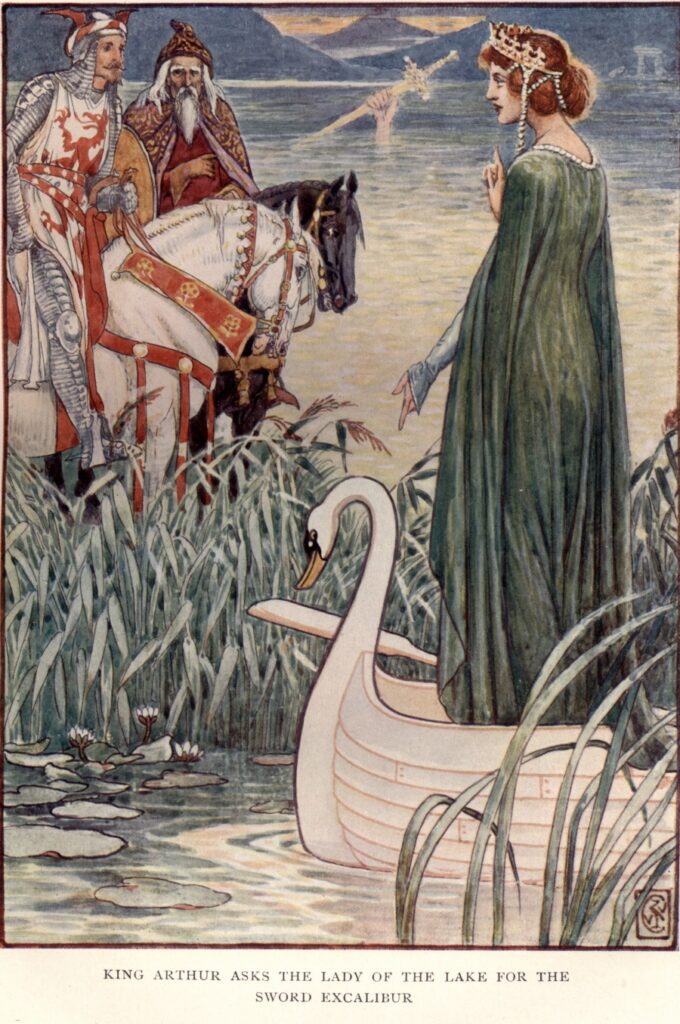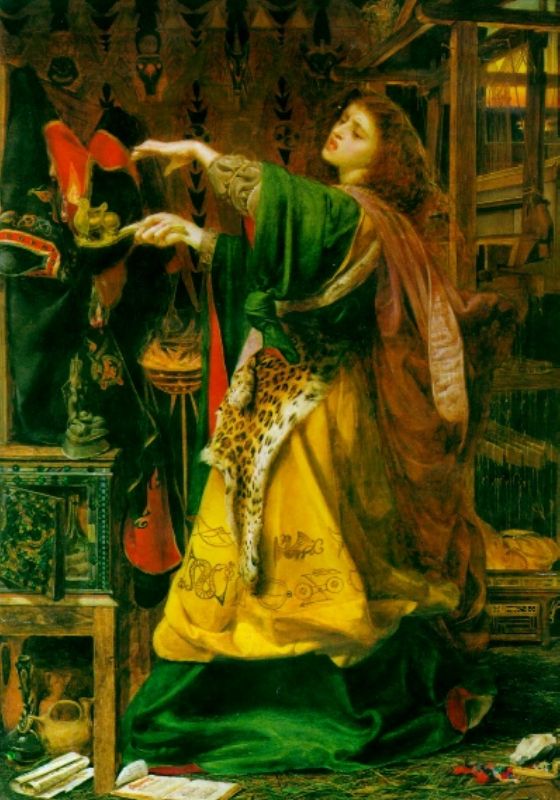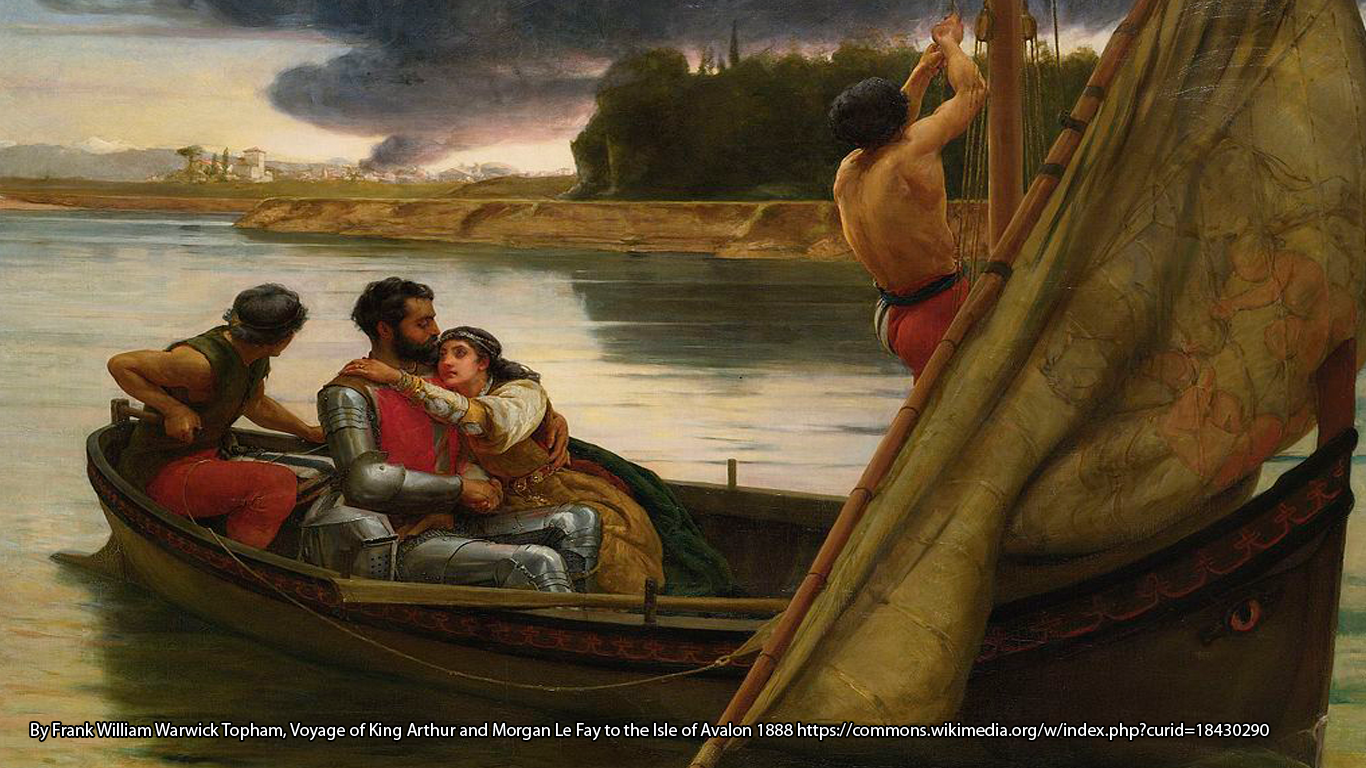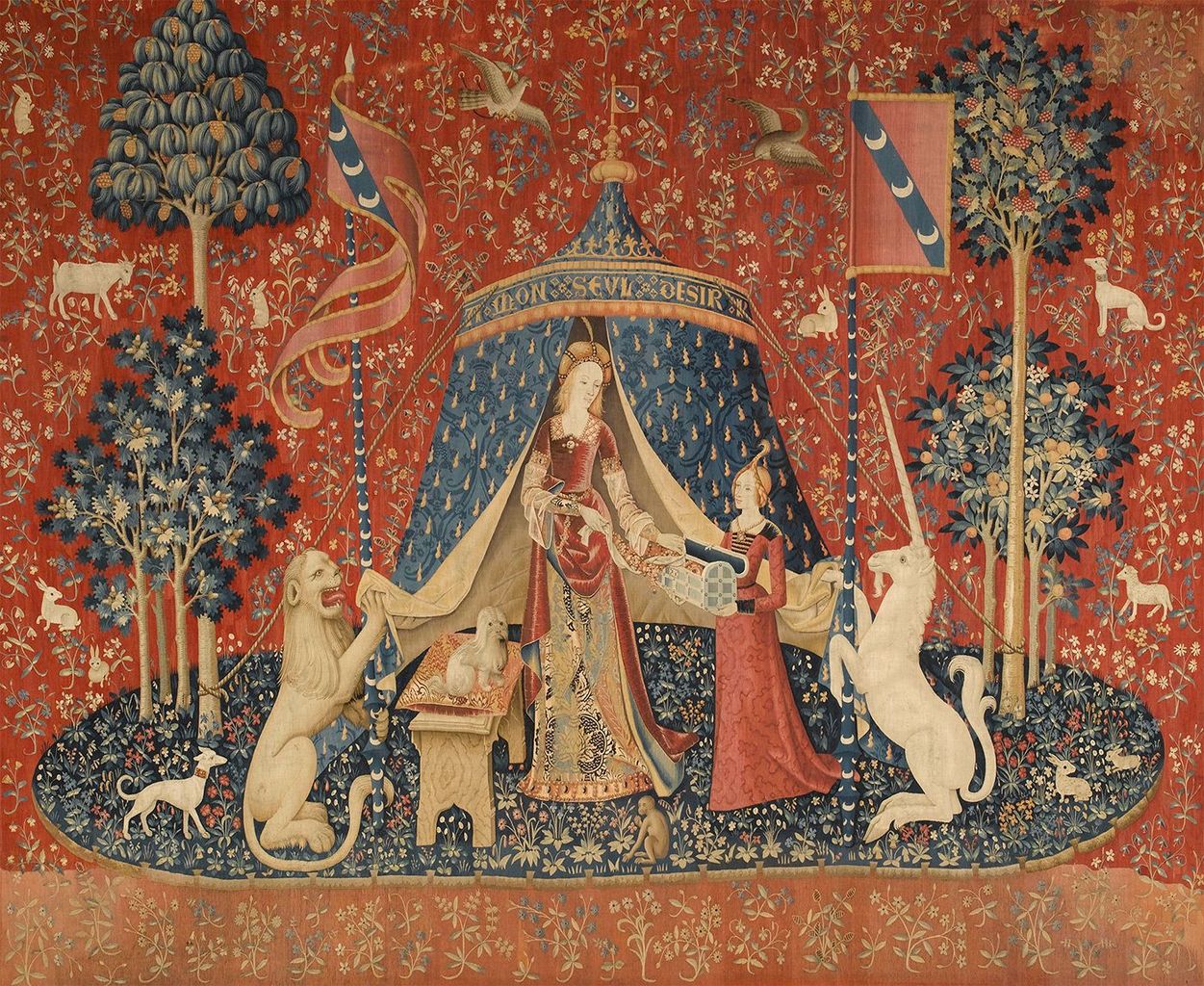In Arthurian tradition, the elusive sorceress Morgan le Fay becomes one of King Arthur’s most dangerous foes, breaking traditional family bonds and working to undermine and bring down the strict patriarchal system and chivalric order of the Arthurian world. Morgan is an enigma: despite attempting to kill King Arthur and usurp his kingdom, she takes him into her care after he is severely wounded by Mordred in the battle of Camlann, which brings an end to his kingdom. This work draws mostly from Geoffrey of Monmouth’s Vita Merlini, and Historia regum Britanniae (The History of the Kings of Britain) and Sir Thomas Mallory’s Le Morte D’Arthur, with influences from other texts, and looks at how Morgan’s character changes from benevolent, to malignant and then back to benevolent. To do this, we look at her early life, how she used Arthur’s famous sword Excalibur against him and stole its scabbard, and the disaster this would cause. This is followed by a discussion on two important topics that had a considerable influence on medieval society: the Querelle des Femmes or the Woman Question, and witchcraft, before concluding with Morgan’s return to Avalon.
As Ruler of Avalon
Geoffrey of Monmouth introduces Morgan into Arthurian literature in Vita Merlini, as ‘Morgen’, presenting her as the leader of nine benevolent sisters that rule the island of Avalon. She is the most beautiful, the most knowledgeable and the most powerful of the sisters. As well as being a skilled healer, she can fly or transport herself at will from place to place, and she has shape-shifting abilities.
It is not clear whether these ‘sisters’ are family, or members of some kind of religious or mystical order. In the work of some later writers, she becomes either the step-sister or full elder sister of King Arthur, but a radical change happens with her character. As Arthur’s elder sister, she breaks the traditional bond of love between brother and sister and the nurturing role so often associated with the elder sister towards their younger brother. Furthermore, instead of the wise and benevolent sorceress, she evolves into a malign, sexual predator, hating her brother and his wife Queen Guinevere, and forsakes her place at the centre of the Arthurian establishment, moving to its periphery and becoming a renegade attacking the established order. She targets the Knights of the Round Table, especially Sir Lancelot, weaving dark spells and plots to trap them. Eventually, she becomes nothing less than an enemy of the state and, arguably, its most dangerous adversary, until Mordred emerges to usurp the crown, resulting in the battle of Camlann.
Morgan’s Early Life
In Historia Regum Britanniae, Geoffrey of Monmouth makes Morgan the youngest daughter of Gorlois, Duke of Cornwall, and his wife Igraine. When the King of the Britons, Uther Pendragon, first set eyes on Igraine, he became wildly infatuated with her. Unable to contain his lust, he attacked Cornwall to take Igraine for himself. Gorlois sent his wife to his safest stronghold of Tintagel while he confronted Uther’s troops in battle. While the military confrontation took place, Merlin, using his magical arts, transformed Uther into the likeness of Gorlois to allow him to gain access to Igraine at Tintagel. The guards, believing it was Gorlois, let him enter the stronghold. Believing he was her husband, Igraine lay with him, and that night Arthur was conceived.
While this was taking place, Gorlois was killed battling Uther’s army. After satisfying his lust, Uther returned to his troops and, on learning of the death of the duke, took Igraine to be his wife. He married her eldest daughter, Morgause, to King Lot of Lothian and the next eldest, Elaine, to King Nentres of Garlot. Morgan was the youngest and he sent her to a nunnery.
Morgan hated Uther because she knew what had happened the night her father died, and deeply resented Arthur as the product of his lust. At the nunnery, she was introduced to astrology, the dark arts of necromancy and the skills of healing, becoming highly adept in this field. As her skill and knowledge grew, people began to call her Morgan le Fay in acknowledgement of her abilities. Eventually, she joined Arthur’s court and became a lady in waiting to Queen Guinevere.
Morgan and Guiomar
Morgan was a very attractive young woman; a good singer and musician, marvellously skilled with her hands and very intelligent and well spoken. For the most part, she was considerate and courteous, but when angered became vindictive, spiteful and obstinate. She was alleged to be the lewdest and most lustful woman in Britain, taking many lovers.
One day, Guinevere’s nephew, Guiomar, found her while she was at work in a bedroom spinning golden thread and the two fell in love at first sight. The lovers tried to keep their affair secret but eventually, Guinevere found out and banished her kinsman from the court. This incident caused Morgan to develop a burning resentment towards her, and increased her own animosity towards Arthur which so far she had kept hidden.
She left the court and studied further the arts of sorcery, enhancing her magical abilities greatly. Eventually, she returned to Camelot and to create a strategic political alliance, Arthur married her to King Urien of Rheged, causing further resentment. She had a son by him named Owain but began secretly plotting the downfall of her husband and her brother.

The Lady of the Lake and Excalibur
One of the great icons of Arthurian tradition was his famous sword Excalibur. Arthur had obtained this after he had broken the sword he pulled from the stone in battle, and, needing a replacement, Merlin took him to the shores of a lake. From the shore gazing towards the centre of the lake, he could see an arm holding a bright sword aloft out of the water. The Lady of the Lake came to him and Arthur asked her if she would give him the sword, promising in return to give her anything she asked. She told him to take the boat on the shore out to the arm and he would be given the sword and a scabbard. When the time came, she would ask him to fulfil his part of the bargain.
Arthur and Merlin went in the boat across the lake to where the arm held the sword out of the water. Arthur did as she said and received the sword and scabbard. They returned to shore where he looked at the sword which was beautifully made from the highest craftsmanship. Merlin asked him whether he preferred the sword or the scabbard.
“Which do you like best, the sword or the scabbard?”
“I prefer the sword.”
“Then you are a fool! The scabbard is worth ten of the sword because while you wear it no matter how you are wounded you will not lose blood. Always keep the scabbard safe by you at all times.”
The Scabbard of Excalibur
Time passed. During a battle, Arthur was wounded but the wound produced no blood. Merlin reminded him that this was because of the scabbard of Excalibur and again warned him to keep it safe.
At this stage, Arthur still loved and trusted his sister Morgan, even more than his wife Guinevere. Therefore, he took the scabbard and Excalibur to her and asked her to keep both safe. However, Morgan secretly hated her brother and she saw this as an opportunity to bring him down. She made a counterfeit scabbard and sword and gave the real items to her lover Accolon. Her plan was for him to kill Arthur in a duel and then together they would usurp the crown. To bring this about, she cast a complicated spell that brought the two of them to face each other in combat away from Camelot.
She sent Arthur the counterfeit Excalibur and its scabbard to use in the duel, while the real items were being used by Accolon. In the duel that followed, Arthur was being badly beaten and was bleeding from many wounds dealt by Accolon wielding Excalibur. Accolon, despite receiving numerous blows by Arthur, remained unbloodied. Weakened by loss of blood Arthur realised that his opponent was wielding the real Excalibur and wearing the real scabbard. As Accolon raised Excalibur to strike the death blow, the Lady of the Lake intervened, casting a spell that made him drop the sword. Arthur seized his chance and grabbed the blade. Tearing the scabbard from Accolon, he hurled it away. Now wielding Excalibur, Arthur defeated his opponent, badly wounding him in the process.
With Accolon at his mercy, Arthur demanded an explanation of how he got Excalibur and its scabbard. Accolon told him of Morgan’s plot and how she hated and despised him. On hearing this, Arthur was genuinely shocked. He had loved and trusted his elder sister completely and to learn that she hated him hurt deeply. Despite his shock and grief, Arthur would have spared Accolon, but he died four days later from his wounds. Arthur sent Accolon’s body to Morgan and, still weak from loss of blood, decided to rest at a nearby nunnery to recuperate.
While Accolon and Arthur had been locked in mortal combat, Morgan herself had been busy at Camelot. As her husband, King Urien, lay sleeping, she had crept up to him with a knife, intending to murder him. Her son, Owain arrived by chance in time to stop her carrying out the fatal blow. Owain would have killed his mother, but she claimed she had been afflicted by a sudden bout of madness, and, believing her, he spared her life.
The Theft of the Scabbard
Morgan had truly loved Accolon. Devastated by his death and the failure of her plot, she sought vengeance. On receiving his body, she went to Guinevere, who at this stage was unaware of the fight between Arthur and Accolon, to request leave from the court, claiming she had received urgent news and needed to travel home to deal with it.
Guinevere reluctantly gave consent and, at dawn the next morning, Morgan left on horseback with a retinue of her own knights. After riding hard all day and all night they reached the abbey where Arthur was recuperating. She was met by the nuns who took her to his room and offered to wake him. “Nay, let him be,” she said. “I will wake him later when he is rested. Now, leave me with him!” The nuns were terrified of Morgan and obeyed her without question.
Arthur was lying fast asleep on a bed in the room, and in his right hand he tightly gripped Excalibur. Morgan thought about trying to steal the sword, but she knew if he should wake he would surely kill her now. She decided she would not take the chance, and seeing the empty scabbard close by, hid it under her cloak and rode off with her retinue following.
When Arthur awoke, he immediately discovered the scabbard was missing. Calling the nuns to him, he questioned them about what had happened while he slept. They told him about the visit of his sister and how she had ordered them out of the room leaving her alone with him. On hearing this, Arthur ordered Sir Ontzlake to prepare their horses and they set off after her.
Riding hard and fast, they eventually caught sight of her and her knights in the distance. Looking back, Morgan saw it was Arthur and realised she could not escape. Despite having a company of knights, she knew they were no match for Arthur and Sir Ontzlake. Nevertheless, she was determined he would not get the scabbard back. Riding to a nearby lake, she threw it far into the water where the weight of the gold and jewels that embellished it quickly took it to the bottom.
Looking to escape Arthur, Morgan and her knights galloped into a valley, where the sides were littered with great blocks of stone. With her magic arts, she turned herself and her knights into blocks of stone. Just as she had done this, into the valley rode King Arthur and Sir Ontzlake, who looked around the valley but could only see blocks of stone. Unable to find a trace of her, Arthur searched for the scabbard hoping she had dropped it for them to find. Finding no trace, he returned to the Abbey.
As soon he had gone, Morgan turned her knights and herself back into human form and rode back to her home country. Fearing her brother may seek revenge for her part in his attempted assassination and theft of the scabbard, she made strong her castles and town walls, for now she was an enemy of the Arthurian state.
Arthur rode back to Camelot where Queen Guinevere and the Knights of the Round Table warmly welcomed him home. On hearing his story of the fight with Accolon, Morgan’s plot to take the crown and how she had stolen the scabbard of Excalibur, they were outraged. They accused her of treason and demanded that she be burnt at the stake.
The Deadly Cloak
Despite the failure of her murderous plot, Morgan’s hatred for her brother had not diminished and she came up with another plan to assassinate him. She sent one of her girl servants to Camelot bearing him a most handsome cloak as a peace gift, begging his forgiveness. It was studded with precious gems and embroidered with threads of gold and silver, and Arthur was greatly impressed. As he was about to try it on, the Lady of the Lake intervened saying, “Sire, do not try on the cloak yourself, or let any of your knights try it until she who has brought this gift to you has worn it herself.”
“Perhaps you are right, I will follow your counsel,” he told her thoughtfully and called the girl to him. “Place this cloak over your shoulders that I may see how it looks worn,” he told her.
“Sire, it is not my station to wear the clothes of a King!” she protested.
“You must first wear it before I or any of my knights try it on!” he told her sternly and motioned for the cloak to be placed upon her shoulders. This was done and the cloak burst into flames turning the girl to ashes. Arthur was furious at the treachery of his sister and terribly hurt and bewildered that she would have killed him in such an awful fashion.
Morgan’s Magic
Having been thwarted in her plot, Morgan feared her brother’s vengeance. She removed herself to live in the outskirts of his kingdom in the forests and wild places, building her own realm on the edge of Arthur’s. She immersed herself into further study of the arts of sorcery, eventually becoming so powerful and adept that people spoke of her as a goddess.
At every opportunity, Morgan sought to capture and imprison any of the Knights of the Round Table who came her way, especially Lancelot who she captured several times. She had an unrequited love for him, but her intention in capturing him was also to hurt Guinevere and Arthur.

The Murals of Lancelot
During one period of confinement, Lancelot painted a mural depicting his life on the walls of his prison, which clearly included his love affair with Guinevere. Years after he had been released, King Arthur and some of his knights came across Morgan’s castle. Arthur had heard nothing of Morgan for years and believed his sister to be dead. Seemingly forgetting and forgiving past wrongs, he was overjoyed to discover she was still alive and invited her to return to Camelot with him, but she told him,
“Do not ask this of me, for I will never return to court. When I finally leave this place I will go to the Isle of Avalon where the women live who know all the magic in the world.”
Guiding him around her castle, she took great pains to show him the murals that Lancelot had painted. As soon as he saw them, he realised that Guinevere and Lancelot had been having a long love affair and was deeply upset. Morgan seized upon this, encouraging him to take vengeance on the betrayal of his trust by the two people who were closest to him in the world.
This and other events would eventually lead Arthur reluctantly to go to war with Lancelot, who would retreat to his own castle in France with Guinevere. Arthur left Mordred as steward of his kingdom and went to war with Lancelot, but he was to betray him and usurp the crown. Arthur was forced to return for the final confrontation at the apocalyptic battle of Camlann where he killed Mordred but, bereft of the scabbard of Excalibur, was mortally wounded.
If Morgan had not stolen and disposed of the original scabbard of Excalibur, Arthur would have worn it at Camlann and been protected from harm. Thus it was that Morgan may have been indirectly responsible for the seriousness of his injury and yet it was she, despite her hatred, that took him for healing in Avalon.
Querelle des Femmes, or the Woman Question
In much of Arthurian literature, the Woman Question and the witchcraft threat are presented through Morgan, mirroring the challenges and threats these topics were seen to present in medieval times to the established patriarchal order.
The Querelle des Femmes appeared during the 15th century, and was a literary debate discussing the role of women in medieval society and areas they were excluded from including; politics, religion and other fields. There were arguments both for and against greater female involvement. The debate began in France around a work called Le Roman de la Rose, begun by Guillaume de Lorris and concluded by Jean de Meun, which spread around Europe, dividing the literary world. It centred on Meun’s misogynistic and stereotyped ideas on the female status and those who challenged and rejected them. In Morgan, these arguments are seen through her behaviour, the behaviour of other male and female characters, their roles in society and their relationships.
Witchcraft
The belief in magic goes back to the earliest times of humanity. Sorcery, enchantment and other forms of magic are an important part of the Arthurian world and were also widely accepted as part of medieval life, co-existing with Christianity as it does in Arthurian texts. Eventually, it became unacceptable to the Christian Church as a severe threat, particularly from women, who too often suffered the consequences.
The Lady of the Lake saves Arthur from Morgan’s plots to kill him and is seen in social terms as the good woman upholding and defending the patriarchal order, while Morgan is the bad woman, the renegade, who does not behave as she is supposed to. Unable to directly fight in combat because of her sex, she uses the chivalric order to attack the strictly patriarchal Arthurian state. She used Accolon to fight with Arthur, turning the chivalric rules against him and even his own sword, Excalibur, was used against him.
Far from a passive participant in events, like Guinevere who gets abducted several times, Morgan is an active agent, and it is she who abducts Arthur’s knights. An independent, strong-willed, active, intelligent woman armed with sorcery is seen as a danger to patriarchy and medieval society. To counter this, she is given a reputation of sexual predation, treachery to the family – the cornerstone of medieval society – and her magic becomes witchcraft. Her role is presented to the reader as an example of everything a high-status woman in medieval society should not be, hence the need to alienate her. This staining of her character is the consequence of her magic, independence, and intelligence.
Return to Avalon
After the battle of Camlann, Morgan had Arthur completely helpless, in her power and at her mercy. Yet her character now appears to have gone full circle. With him at her mercy, instead of killing him, she becomes the loving sister and the benevolent sorceress taking up the traditional passive, healing, nurturing role so often associated with good women in medieval society. Despite the fall of the great Arthurian order, patriarchy is not dead, and there seems to be no place in what remains for her and as she foretold she will be found on “the Isle of Avalon where the women live who know all the magic in the world”.
Just like Morgan le Fay, Arthurian tales can be healing, dangerous, wonderful, tricksy and very much open to interpretation. It is from the sorcery of words that the reader creates their own magical, meaningful experience, and that is really what matters.
To read all the articles in this series, visit the British Legends Series page or select from the list below:
- British Legends: The Quest for the Holy Grail
- British Legends: The Founding of Britain: Brutus of Troy and the Prophecy of Diana
- British Legends: The Mabinogion – The Dream of Macsen Wledig
- British Legends: Gogmagog and the Giants of Albion
- British Legends: Treachery, Murder, Lust and Rowena: The Rule of Vortigern
- British Legends: The Origin of Albion and the Bloodlust of Albina and Her Sisters
- British Legends: The Lust of Uther Pendragon, Merlin’s Prophecy and the Making of a King
- British Legends: Aurelius Ambrosius, Legendary King of the Britons
- British Legends: Elen of the Hosts – Saint, Warrior Queen, Goddess of Sovereignty
- British Legends: Beowulf and the Great Flame Dragon
- British Legends: The Divine Tragedy of Guinevere
- British Legends: The Tragic Romance of Tristan and Isolde
- British Legends: Morgan le Fay – Magical Healer or Renegade Witch?
- British Legends: The Madness of Merlin (Part 1)
- British Legends: The Madness of Merlin (Part 2)
- British Legends: Warrior Women — The Battle of Britomart and Radigund the Amazon Queen
- Mythical Beasts: The Griffin, the Legendary King of All Creatures
- British Legends: King Lear and Cordelia – A Tale of Love and Foolishness
- British Legends: Wild Edric, the Wild Hunt and the Bride from the Otherworld
- British Legends: The Outlaws of Inglewood and the Feminine Influence
Recommended Books from #FolkloreThursday
References and Further Reading
Vita Merlini – Geoffrey of Monmouth
Le Morte D’Arthur, Volume I (of II), by Thomas Malory
[PDF] The Role of Morgan le Fay in Thomas Malory´s Morte D’Arthur
Le Morte d’Arthur: Volume 2 by Sir Thomas Malory
British Legends: The Lust of Uther Pendragon, Merlin’s Prophecy and the Making of a King
Five Legendary Islands from Folklore
[PDF] Goddess Dethroned: The Evolution of Morgan le Fay – ScholarWorks
Dalecky, Elke (2008). Different Faces of Morgan le Fay: The Changing Image of the Sorceress in Arthurian Literature (PDF). University of Vienna.
[PDF] the Role of Morgan le Fay in Thomas Malory´s Morte Darthur
Morgan le Fay: Magic, Mysticism, and Misogyny







![Boadicea, leader of the rebellion against the Romans. By Joseph Martin Kronheim (1810–96)[1] - This file has been extracted from another file: Pictures of English History - Plates I to IV.jpg, Public Domain, https://commons.wikimedia.org/w/index.php?curid=12705208](https://folklorethursday.com/wp-content/uploads/2020/10/Pictures_of_English_History_Plate_IV_-_Boadicea_and_Her_Army.jpg)




